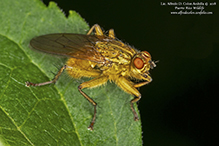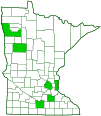Golden dung fly
(Scathophaga stercoraria)
Conservation • Description • Habitat • Ecology • Distribution • Taxonomy
Conservation Status |
|||
| IUCN Red List | not listed |
||
| NatureServe | NNR - Unranked |
||
| Minnesota | not listed |
||
Description |
Golden dung fly occurs in Europe, Africa, Japan, and North America. It is very common throughout the United States and in southern Canada. In some areas it is one of the most abundant species of fly. It is found wherever large mammals occur, especially in cattle farming areas. Adults are slender, ¼″ to ⅜″ long, and similar to house flies in appearance. Males are larger and golden-brown, females are smaller and greenish. Both sexes are hairy, but the male is much hairier. There are bristles on the face and on the top of the head. There are two large compound eyes at the side of the head and three small simple eyes (ocelli) in a triangle at the top of the head. The compound eyes are orangish-brown and hairless. They do not meet at the top of the head in either sex. There is a V-shaped groove (suture) on the face just above the antennae bases. The antennae have three segments. The second segment has a longitudinal groove (suture) on top. The third segment has a short, forward-pointed bristle (arista) on the upper side. The thorax is heavily bristled. The plate (hypopleuron) on the thorax just above the basal segment of hind leg (coxa) has no bristles. The plate between the throax and the abdomen (scutellum) has four bristles. The abdomen is slender and densely covered with hairs. As with all flies, there is only one pair of wings, the hind wings being reduced to small, knob-like structures (halteres) that are used for balance in flight. The wings are smoky brown and clear, with no dark spots. At the base of each wing there are two small, rounded lobes (calypters) that cover the halteres. The calypters are well-developed. The first posterior cell (R5) is has parallel sides. The second anal vein (2A) reaches the inner margin. The legs are long and slender. The third segment (femur) of each leg on the male is densely covered below with long, brightly colored hairs. On the female, the femora have fewer hairs, and those are not brightly colored. |
Size |
Total length: ¼″ to ⅜″ |
Similar Species |
Habitat |
|
Ecology |
Season |
Two to four generations per year: March to November |
Behavior |
|
Life Cycle |
Eggs are laid on raised areas of the dung of large mammals, especially cattle. The eggs hatch in one or two days. The larvae burrow into the soil and pupate after 10 to 20 days. Juvenile flies emerge in 10 to 80 days, depending on the temperature. Adults live one or two months. There are two to four overlapping generations per year. |
Larva Food |
Dung of large mammals |
Adult Food |
Mostly other fly species, occasionally other insects, including other golden dung flies when other food is scarce |
Distribution |
||
|
Sources |
|
| 8/27/2025 | ||
Occurrence |
||
Very common |
||
Taxonomy |
|
Order |
|
Suborder |
Brachycera |
Infraorder |
Cyclorrhapha |
Zoosection |
Schizophora |
Zoosubsection |
|
Superfamily |
Muscoidea |
Family |
Scathophagidae (dung flies) |
Subfamily |
Scathophaginae |
Tribe |
Scathophagini |
Genus |
Scathophaga |
Subordinate Taxa |
|
|
|
Synonyms |
|
Amina parisiensis Chione ichneumonea Musca exilis Musca stercoraria Scathophaga alpestre Scathophaga asticha Scathophaga disticha Scathophaga exilis Scathophaga nigricans Scathophaga polysticha Scathophagaster coraria Scatomyza erythrostoma Scatophaga asticha Scatophaga claripennis Scatophaga disticha Scatophaga humilis Scatophaga merdivora Scatophaga nigricans Scatophaga polysticha Scatophaga stercoraria Scopeuma alpestre Scopeuma stercoraria |
|
Common Names |
|
golden dung fly yellow dung fly |
|
Glossary
Arista
A large bristle on the upper side of the third segment of the antenna of a fly. Plural: aristae.
Calypter
On flies: one of two small membranous lobes at the base of the forewing that covers the haltere.
Femur
On insects and arachnids, the third, largest, most robust segment of the leg, coming immediately before the tibia. On humans, the thigh bone.
Halteres
In flies: a pair of knob-like structures on the thorax representing hind wings that are used for balance.
Ocellus
Simple eye; an eye with a single lens. Plural: ocelli.
Scutellum
The exoskeletal plate covering the rearward (posterior) part of the middle segment of the thorax in some insects. In Coleoptera, Hemiptera, and Homoptera, the dorsal, often triangular plate behind the pronotum and between the bases of the front wings. In Diptera, the exoskeletal plate between the abdomen and the thorax.
Visitor Photos |
Share your photo of this insect. |
||
This button not working for you? |
||
Alfredo Colon |
 |
MinnesotaSeasons.com Photos |
|

Slideshows |
Scathophaga stercoraria |
About
Scathophaga stercoraria Yellow Dung fly |

Visitor Videos |
Share your video of this insect. |
||
This button not working for you? |
||
|
Other Videos |
Furry Yellow Dung-Flies (Scathophaga stercoraria) |
About
Published on Apr 26, 2013 There was some composting waste stuck in the bottom of the 'Green' recycling bin. After it was emptied out (be grateful youtube doesn't let you smell!) these flies appeared. The males are the furry yellow, the females look more like normal flies. They are known as the yellow or golden dung-fly (Scathophaga stercoraria). https://en.wikipedia.org/wiki/Scathophaga_stercoraria *****Music Copyright Information for YouTube***** Music: Jackpot http://www.jamendo.com/en/track/42796... https://creativecommons.org/licenses/by-sa/3.0/ |
Golden Dung Fly (Scathophagidae: Scathophaga stercoraria?) Feeding |
About
Published on Jul 2, 2011 Photographed at the Rydell NWR, Minnesota (29 June 2011). |
strontvliegen (Scathophaga stercoraria) |
About
Published on Jul 24, 2014 Stront of drekvliegen |
Gelbe Dungfliege (Scathophaga stercoraria) |
About
Published on Apr 30, 2015 Zur Paarung treffen sich die Gelben Dungfliegen auf noch warmen Dung (z.B. Pferdeäpfeln oder Kuhfladen) und legen darin ihre Eier ab. |

|
Created: 2/5/2019 Last Updated: © MinnesotaSeasons.com. All rights reserved. |


